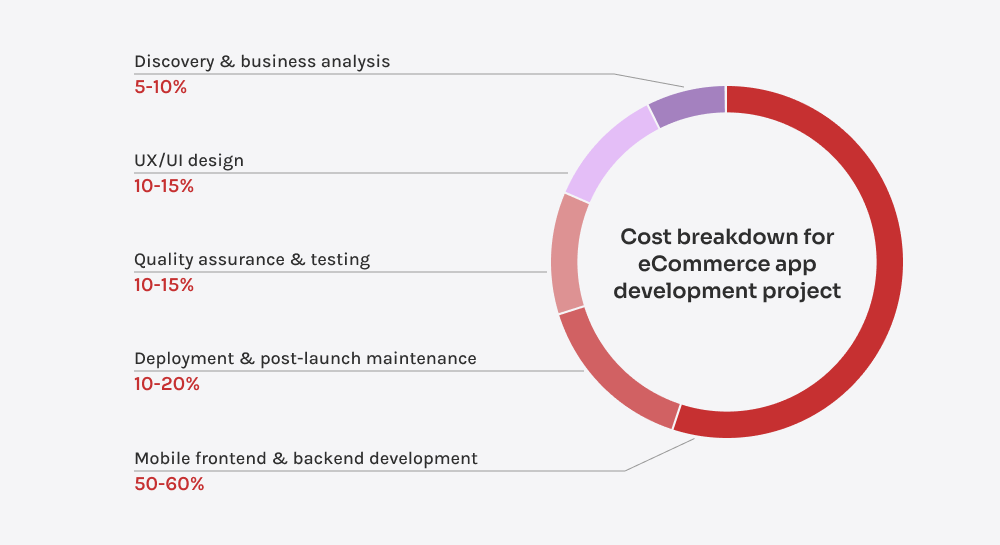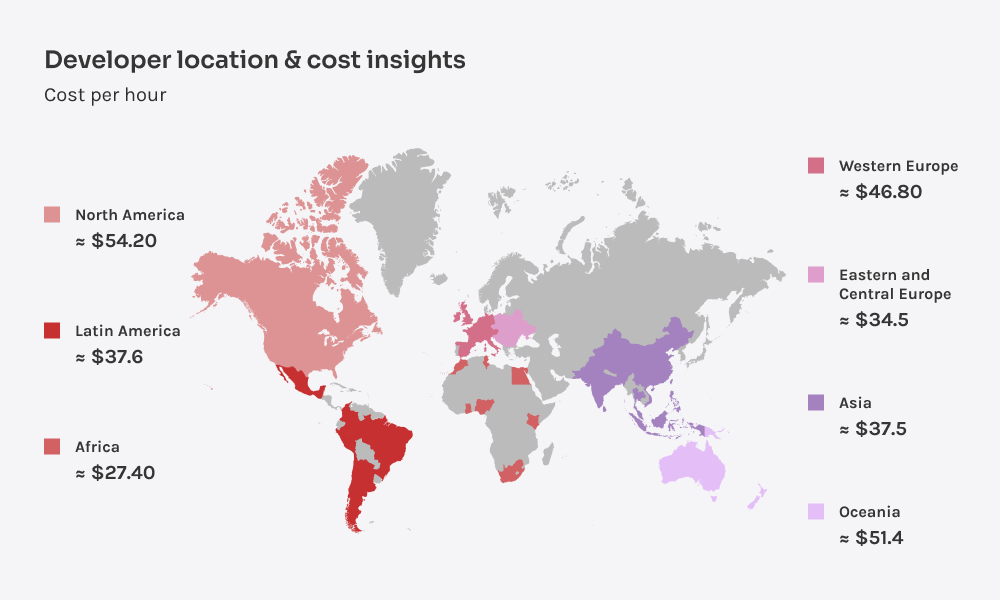Il tuo messaggio è stato inviato.
Elaboreremo la vostra richiesta e vi ricontatteremo al più presto.
Il modulo è stato inviato con successo.
Ulteriori informazioni sono contenute nella vostra casella di posta elettronica.

Selezionare la lingua


La creazione di un'applicazione di e-commerce è un'esperienza entusiasmante e gratificante, ma come molti proprietari e dirigenti d'azienda sanno, il lato dei costi può diventare rapidamente schiacciante.
È fin troppo facile valutare male le spese da sostenere, con il risultato di prendere decisioni difficili in futuro — come bilanciare la qualità con il budget? Che senso ha assicurarsi che tutti i fornitori siano ugualmente trasparenti nei loro prezzi? Questi ostacoli sono fin troppo frequenti e possono trasformare il processo di sviluppo in un mal di testa anziché in una svolta.
Ho creato questa guida per semplificarvi la vita quando si tratta di capire i costi reali di sviluppo di un'app di e-commerce. Nelle prossime sezioni, analizzerò i diversi elementi che concorrono alla determinazione dei prezzi e come bilanciare il budget con la qualità. Inoltre, tratterò alcuni degli errori più comuni che ho visto e come evitarli. Andiamo!
Quanto costa sviluppare un'app di e-commerce? In realtà, non esiste un approccio univoco. Tutte le app sono diverse in termini di complessità, funzionalità e design da soddisfare. Perciò, per ottenere un costo accurato, ha senso approfondire tutti i fattori critici quando si inizia a pensare ai costi di sviluppo di un'app mobile per l'e-commerce. Questo è esattamente ciò che ho fatto.
Funzionalità semplici come un catalogo di prodotti o una ricerca di base sono relativamente poco costose. Ma le funzioni più sofisticate, come i gateway di pagamento, le raccomandazioni guidate dall'intelligenza artificiale o il monitoraggio in tempo reale, hanno un costo elevato. Ogni funzione aggiunge un livello di difficoltà e richiede più tempo, risorse ed esperienza per essere implementata.
Creare un'app che sembri unica e ricca aiuta a distinguersi dalla concorrenza e ad attirare più clienti, ma preparatevi a investire di più per questo lusso.
Catalogo prodotti
Un catalogo di prodotti serve come vetrina digitale dove i clienti possono esplorare senza sforzo gli articoli disponibili. Presentare la merce in un layout pulito e organizzato, con categorie ben definite e filtri intuitivi, trasforma la navigazione in un'esperienza senza soluzione di continuità. Funzioni strategiche di raccomandazione come "I clienti hanno acquistato anche" o "I prodotti più richiesti" migliorano la navigazione e favoriscono in modo sottile le vendite.
Carrello della spesa
Il carrello della spesa rappresenta più di un semplice strumento di transazione: è un punto di contatto critico nel percorso del cliente. Indipendentemente dal fatto che si tratti di un carrello di base o ricco di funzionalità, il suo design deve privilegiare la facilità d'uso e l'interazione intuitiva. Ridurre l'attrito e la complessità è fondamentale, in quanto esperienze di carrello complicate possono portare rapidamente all'abbandono degli acquisti e alla perdita di fatturato.
Processo di checkout
Un processo di checkout efficace funge da passaggio finale tra l'interesse e la conversione. Il supporto di diversi metodi di pagamento, come PayPal, Stripe e carte di credito, crea flessibilità per i clienti. L'ottimizzazione del flusso con funzioni come l'autocompilazione dell'indirizzo può ridurre significativamente i tassi di abbandono e aumentare la soddisfazione complessiva degli utenti.
Autenticazione dell'utente
Gli account utente trasformano le interazioni transazionali in esperienze personalizzate. Dare ai clienti la possibilità di tracciare gli ordini, salvare le preferenze e personalizzare la loro esperienza trasforma l'autenticazione in uno strumento per costruire relazioni, non solo per la sicurezza. Semplificare l'accesso attraverso i login dei social media o il single sign-on (SSO) riduce l'attrito, mentre solide opzioni di recupero della password assicurano che gli utenti non si sentano mai chiusi fuori dal loro spazio digitale.
Notifiche push
Le notifiche efficaci raggiungono un delicato equilibrio tra la capacità di informare e quella di non essere invadenti. Avvisi tempestivi e pertinenti mantengono i clienti in contatto senza sopraffarli, fornendo aggiornamenti critici sugli acquisti, sullo stato delle spedizioni e sulle promozioni personalizzate. L'obiettivo è creare un senso di coinvolgimento che sia utile, non invasivo.
Recensioni e valutazioni dei prodotti
Le recensioni dei clienti sono diventate l'equivalente digitale del marketing del passaparola. Consentendo feedback dettagliati e valutazioni a stelle, le aziende trasformano l'acquisto da una decisione solitaria a un'esperienza guidata dalla comunità. Le recensioni filtrabili aiutano i potenziali acquirenti a orientarsi con sicurezza, trasformando la saggezza collettiva dei consumatori in un potente strumento di acquisto.
Assistenza clienti
Un'assistenza clienti eccezionale va oltre la risoluzione dei problemi: si tratta di creare esperienze memorabili che trasformano le transazioni in relazioni durature. Quando i clienti si sentono apprezzati e ascoltati, l'assistenza smette di essere un centro di costo e diventa un motore strategico di fidelizzazione che costruisce la fedeltà al marchio.
Condivisione sociale
La condivisione sociale trasforma i clienti in ambasciatori del marchio, sfruttando le reti personali come canali di marketing potenti e autentici. Quando gli utenti condividono volontariamente le esperienze sui prodotti, generano una visibilità credibile e organica che la pubblicità tradizionale non può replicare. Questo approccio di raccomandazione peer-to-peer guida il traffico e costruisce una vera e propria fiducia e comunità intorno a un marchio.
Lista dei desideri
Le liste dei desideri fungono da segnalibri digitali, consentendo ai clienti di selezionare ed esplorare i potenziali acquisti al proprio ritmo. Questa funzione consente di creare un ambiente poco pressante che rispetta il processo decisionale del cliente, pur mantenendo un invito aperto a tornare. È un modo sottile ma efficace per mantenere i prodotti in primo piano senza tattiche di vendita aggressive.
Raccomandazioni di prodotto basate sull'intelligenza artificiale
L'intelligenza artificiale (AI) eleva la personalizzazione da concetto generico a esperienza di acquisto su misura. Analizzando la cronologia di navigazione individuale e i modelli di comportamento più ampi degli utenti, l'intelligenza artificiale nell'e-commerce crea raccomandazioni dinamiche e in continua evoluzione, intuitivamente pertinenti. Con questo approccio, i suggerimenti di prodotti si trasformano da scoperte casuali a scoperte curate con attenzione.
Prova AR
La realtà aumentata (AR) colma il divario tra la navigazione digitale e l'interazione fisica, consentendo ai clienti di visualizzare i prodotti nel loro contesto preferito. Sfruttando la visione computerizzata avanzata e l'apprendimento automatico, le funzionalità di prova AR riducono l'incertezza dell'acquisto e creano un'esperienza di shopping coinvolgente e interattiva che imita l'esplorazione del mondo reale.
Ricerca vocale
Sfruttando l'elaborazione del linguaggio naturale (NLP) e il riconoscimento vocale, il sistema converte l'input vocale in testo, analizza l'intento e recupera i risultati pertinenti. Gli utenti possono dire cose come "Mostrami la cura della pelle vegana" e l'applicazione recupera rapidamente gli articoli corrispondenti. L'intelligenza artificiale avanzata comprende anche gli accenti, il gergo e il contesto, migliorando l'accuratezza e rendendo l'esperienza di acquisto più simile a un dialogo con un assistente esperto che a un processo meccanico di interrogazione.
Supporto multi-valuta e multi-lingua
La funzione multivaluta converte automaticamente i prezzi in base alla posizione o alla scelta preferita dell'utente, integrandosi con le API dei tassi di cambio in tempo reale per garantire la precisione. Supporta inoltre diversi metodi di pagamento.
Il supporto multilingue adatta l'interfaccia dell'app, le descrizioni dei prodotti e l'assistenza clienti a diverse lingue, spesso utilizzando la traduzione assistita dall'intelligenza artificiale per garantire la scalabilità. Alcuni sistemi adattano anche le sfumature culturali, come i formati delle date o le convenzioni di dimensionamento.
Tracciabilità dell'ordine in tempo reale
Una volta effettuato l'ordine, l'app si integra con i fornitori di servizi di consegna e utilizza la localizzazione GPS per produrre aggiornamenti aggiornati sulla posizione della spedizione. La trasparenza è diventata la nuova moneta della fiducia dei clienti. La tracciabilità dell'ordine in tempo reale offre ai clienti una visibilità senza precedenti sul loro percorso di acquisto, riducendo l'ansia e creando fiducia.
Caratteristiche del marketing
Gli strumenti di marketing del commercio elettronico si sono evoluti da semplici meccanismi promozionali a sofisticate piattaforme di costruzione di relazioni. Programmi di fidelizzazione, gestione dinamica degli sconti e strategie di campagne personalizzate lavorano in sinergia per convertire gli acquirenti occasionali in sostenitori del marchio a lungo termine. Queste caratteristiche trasformano il marketing da un approccio transazionale a un modello di coinvolgimento strategico.
Lo stack tecnologico scelto, come MEAN, MERN o un backend personalizzato, influisce sia sul costo di sviluppo che sulle spese a lungo termine. Le soluzioni personalizzate spesso costano di più perché richiedono maggiori competenze da parte di professionisti con conoscenze ed esperienze di nicchia. Anche l'aggiunta di servizi di terze parti, come gateway di pagamento o CRM, comporta costi aggiuntivi, tra cui i costi di licenza e lo sviluppo di API. Anche la scalabilità è importante: costruire per la crescita può costare di più all'inizio, ma può evitare costose revisioni in seguito. Scegliere lo stack giusto e pianificare la crescita futura aiuta a gestire sia i costi iniziali che quelli correnti.
La scelta della piattaforma per la vostra applicazione è una decisione strategica che influenza il vostro mercato di riferimento e i costi complessivi dell'applicazione eCommerce. Indipendentemente dalla scelta di Android, iOS o entrambi, ogni piattaforma presenta caratteristiche vincenti. Qui di seguito viene presentata una breve panoramica di ciò che ciascuno dei tipi di sviluppo può apportare alla vostra tavola.
Grazie alle restrizioni di progettazione meno rigide sulle interfacce mobili e alla maggiore libertà dell'interfaccia utente, i costi di sviluppo delle applicazioni Android sono di solito leggermente inferiori a quelli di iOS. Sebbene lo sviluppo di Android tenda ad avere una maggiore frammentazione dei dispositivi e richieda test più approfonditi su schermi di varie dimensioni e versioni del sistema operativo, si tratta comunque di una scelta economica per molte organizzazioni.
Gli utenti iOS hanno generalmente un potere d'acquisto più elevato, il che rende applicazioni iOS interessante per le aziende che si rivolgono ai mercati premium. L'enfasi sulla sicurezza, la continuità dell'interfaccia utente e la stretta aderenza alle linee guida di progettazione di Apple rendono lo sviluppo di app per iOS costoso. Le prestazioni costanti della piattaforma su un numero inferiore di dispositivi offrono un'esperienza utente migliore, ma richiedono una maggiore attenzione ai dettagli.
Per le aziende di e-commerce che desiderano rivolgersi contemporaneamente agli utenti iOS e Android, React Native e Flutter offrono soluzioni efficienti, poiché consentono di creare un'unica app per queste due piattaforme. Mentre lo sviluppo nativo è la scelta migliore per le applicazioni con grafica pesante, per le funzioni AR o per i progetti a lungo termine e su larga scala, le app di e-commerce non rientrano in queste categorie. Nella maggior parte dei casi, gli utenti non sentiranno alcuna differenza, il che rende le app multipiattaforma una scelta intelligente ed economica.
Buttarsi nello sviluppo senza un piano è come salpare senza una mappa: si rischia di bruciare il budget prima di sapere dove si è diretti. Per mantenere l'eCommerce sviluppo di applicazioni mobili per evitare che i costi aumentino vertiginosamente, è necessario suddividere ogni fase di sviluppo. Dopotutto, se non si sa esattamente cosa si sta costruendo, come si può sapere quanto costerà?
Saltare la ricerca è una corsia preferenziale per il superamento del budget. Questa fase comprende ricerche di mercato, analisi dei concorrenti, comprensione del pubblico target, del suo comportamento e definizione dei requisiti dell'applicazione. Una base debole in questo caso può portare a costose riprogettazioni o a perdite di fatturato.
Immaginate di lanciare un mercato della moda di fascia alta senza rendervi conto che il vostro pubblico di riferimento preferisce noleggiare articoli di lusso piuttosto che acquistarli direttamente. Investite molto in un modello di solo acquisto, per poi scoprire che la domanda è bassa e che i concorrenti offrono già opzioni di noleggio. A questo punto, o si elimina l'app o si spendono ancora più soldi per ristrutturare le sue funzionalità principali. Si tratta di una situazione che si sarebbe potuta evitare con un'adeguata ricerca di mercato.
Se gli utenti non riescono a trovare facilmente ciò che cercano, abbandoneranno la vostra app. Se gli utenti incontrano un'app lenta o laggosa, abbandoneranno la vostra app con il carrello abbandonato. Se gli utenti non possono utilizzare la vostra app sul loro iPhone preferito, abbandoneranno la vostra app e non saranno più vostri utenti.
Il risultato? Investire in un sistema di gestione fluido e intuitivo Design UX/UI può sembrare un costo iniziale elevato, ma in realtà si ripaga riducendo l'abbandono del carrello. Tagliare la corda in questo caso è un rischio che potrebbe costare di più in termini di vendite perse rispetto all'investimento iniziale per il design.
La complessità della progettazione UX/UI gioca un ruolo importante nei costi di sviluppo. Un design semplice e adattivo che funziona su tutti i dispositivi è più economico, mentre un design nativo su misura per iOS e Android può richiedere più tempo e investimenti. Se poi si aggiungono animazioni interattive, transizioni personalizzate o gesti avanzati, i costi salgono ulteriormente.
La fase di sviluppo del frontend e del backend occupa in genere la maggior parte del budget, circa 50-60%. Il frontend si concentra sulla costruzione di un'interfaccia ultra-reattiva e facile da usare, mentre il backend fornisce una gestione sicura dei dati e l'integrazione dei pagamenti. Le funzionalità personalizzate, le integrazioni di terze parti e l'hosting su cloud contribuiscono a creare una serie di costi aggiuntivi. Ma ne vale la pena se volete che la vostra infrastruttura sia davvero pronta per la scalabilità.
Il test del software per il commercio elettronico non è facoltativo, a meno che non vi piacciano i disastri post-lancio. Investire in questa fase fa risparmiare denaro nel lungo periodo. Il test manuale prevede che i tester umani esplorino le funzionalità dell'app e identifichino bug e problemi di usabilità, il che lo rende ottimo per valutare l'esperienza dell'utente. Tuttavia, può richiedere molto tempo. I test automatizzati, invece, utilizzano script per eseguire test ripetitivi in modo efficiente e costante, rendendoli essenziali per le applicazioni su larga scala e per i test di regressione. Il bilanciamento di entrambi i metodi garantisce una copertura completa e il lancio di un'applicazione efficiente e priva di bug.
La vostra applicazione non è "finita" quando viene lanciata. Dopo il lancio, la vostra app di e-commerce richiede un'attenzione costante per rimanere aggiornata e funzionale. I costi delle app di e-commerce includono l'hosting, gli aggiornamenti di sicurezza, le correzioni di bug, i miglioramenti delle prestazioni e l'ottimizzazione dell'App Store (ASO). Un buon piano di manutenzione mantiene la vostra app senza intoppi e vi aiuta a evitare costi a sorpresa.

Alcuni costi per lo sviluppo di applicazioni mobili per il commercio elettronico rimangono sepolti nella stampa fine, e molte aziende non ne sono consapevoli. La conformità, la sicurezza, la scalabilità e il marketing possono prosciugare le risorse se non li prevedete, quindi facciamo luce su questi potenziali ostacoli per preparare al meglio il vostro processo di sviluppo.
Conformità a normative quali GDPR, CCPA e PCI DSS è obbligatorio. Tuttavia, il mantenimento di queste regole richiede frequenti aggiornamenti, verifiche e consulenze legali, che possono diventare piuttosto costose. È inoltre necessario mantenere la sicurezza, come ad esempio sistemi di pagamento sicuri, crittografia e rilevamento delle frodi. E infine, test di penetrazione. Evitare di mantenere la conformità e la sicurezza può danneggiare il vostro marchio con fughe di dati, infiniti problemi legali e perdite finanziarie.
Con la crescita della vostra applicazione di e-commerce, i costi di cloud hosting con provider come AWS o Azure possono salire rapidamente. Queste piattaforme offrono flessibilità, ma più risorse si utilizzano (larghezza di banda, database e bilanciamento del carico), più il conto aumenta. E quando la domanda dei clienti aumenta all'improvviso, la scalata per mantenere il funzionamento regolare può far lievitare le spese di infrastruttura e di gestione.
Ammettiamolo: sono necessari investimenti costanti per rimanere visibili in un mercato affollato; ciò include l'esecuzione di campagne pubblicitarie mirate, il miglioramento delle inserzioni dei prodotti, l'impegno con gli influencer e l'affinamento delle strategie dell'app store per mantenere l'app scopribile. Senza un solido piano di marketing e un continuo impegno nell'ASO, l'acquisizione di utenti si riduce, con un impatto diretto sui ricavi e sul ROI a lungo termine.
È impossibile immaginare che un'applicazione di successo funzioni senza aggiornamenti continui, correzioni di bug e manutenzione costante. Con lo sviluppo personalizzato, i costi di gestione aumentano nel tempo, man mano che l'applicazione viene resa operativa, e trascurare questi fattori può far lievitare ulteriormente i costi. Avrete anche bisogno di un team dedicato per gestire l'assistenza clienti, risolvere i problemi e mantenere l'efficienza operativa dell'applicazione.
Al contrario, con le soluzioni uniche, non c'è bisogno di un team di supporto per gestire i bug o fornire assistenza. Tuttavia, queste soluzioni sono spesso soggette a costi di abbonamento ricorrenti. Nel lungo periodo, ad esempio 2,5 anni, queste soluzioni possono risultare più costose delle applicazioni personalizzate.
Quando si tratta di sviluppo eCommerce, perché la geografia è un fattore determinante? L'outsourcing in regioni diverse può spostare totalmente il vostro budget: ogni luogo offre un proprio equilibrio di prezzo e qualità. Arc.dev fornisce un database completo degli stipendi degli sviluppatori remoti, offrendo informazioni sui guadagni nei vari linguaggi di programmazione, framework e livelli di esperienza. Diamo un'occhiata al confronto tra le tariffe.

I budget elevati non sono l'unico modo per ottenere un prodotto di alta qualità. La chiave? Scelte di investimento intelligenti. Vediamone alcune.
Dicono: "Optate per il giusto approccio allo sviluppo!". Ok, ma qual è l'approccio giusto? Come sempre, dipende dalle vostre esigenze, da quanto tempo avete a disposizione e da quanto denaro siete disposti a investire.
Grazie allo sviluppo Agile, le aziende possono sfuggire alla trappola di approcci progettuali inflessibili e ad alto rischio. Questa metodologia suddivide i progetti complessi in fasi strategiche e gestibili che consentono test continui, feedback in tempo reale e aggiustamenti dinamici.
Invece di impegnarsi in una costruzione rigida, tutto o niente, Agile mantiene le funzionalità sviluppate in modo incrementale, mantenendo il team focalizzato sugli obiettivi aziendali principali. Il risultato è un processo di sviluppo semplificato che riduce al minimo gli sprechi di risorse, accelera il time-to-market e fornisce un prodotto di alta qualità senza costi astronomici.
Non è necessario assumere localmente per ottenere competenze di alto livello. Un team ben collaudato in una regione economicamente vantaggiosa può ridurre le spese e fornire un'applicazione di e-commerce di alta qualità.
Per trovare il partner giusto:
L'outsourcing è una mossa strategica che vi dà scalabilità, competenza ed efficienza mantenendo il budget sotto controllo. Con il team giusto al vostro fianco, nulla vi ostacolerà.
Ecco un piccolo consiglio (quasi definitivo): quando stabilite il budget per la vostra app di e-commerce, cercate di puntare su ciò che conta di più! Pensate alle funzionalità che vi daranno il miglior rapporto qualità-prezzo, quelle che non solo renderanno felici i vostri clienti, ma faranno anche crescere la vostra attività. Certo, ogni funzione aggiunge valore, ma il costo per costruirla varia, quindi siate intelligenti. Legate i costi a ciò che ciascuna funzione fa per incrementare le vendite, ridurre i problemi di acquisto e creare clienti fedeli. Qui di seguito è riportata la ripartizione di come le diverse funzionalità possono influire sul vostro ROI.
L'intelligenza artificiale analizza diligentemente il comportamento degli utenti in modo da poter consigliare prodotti tempestivi e pertinenti. Tali raccomandazioni fanno sentire i clienti apprezzati, li incoraggiano a comprare di più e a tornare. Il pricing dinamico interviene con prezzi regolabili in base alla domanda, alla concorrenza e agli acquirenti. Tutto questo contribuisce a rendere lo shopping unico per ogni cliente, fidelizzandolo e facendo aumentare le vendite.
Sono finiti i tempi in cui gli acquirenti avevano la pazienza di accettare pagamenti lenti e senza problemi. Un sistema di pagamento fluido, sicuro e multivaluta è fondamentale nell'ambiente tecnologico di oggi.
Un gateway di pagamento ben ottimizzato significa zero opportunità perse con le opzioni di pagamento locali e nessun (o drasticamente ridotto) fallimento delle transazioni. Sicurezza? Non è negoziabile. Fate in modo che i vostri clienti si sentano al sicuro, o si rivolgeranno altrove.
Perché costruire qualcosa che non crescerà con voi? Un sistema che gestisca senza sforzo il traffico in aumento, gli ordini alle stelle e la mole di dati, senza sudare, è fondamentale per i rivenditori che puntano a una crescita sostenibile. E sono sicuro che voi siete tra questi.
Nessuna costosa rielaborazione, nessun doloroso periodo di inattività, solo un'espansione senza problemi in nuovi mercati con nuove funzionalità pronte per l'uso: può sembrare un sogno, ma è una realtà a cui dovete aspirare per essere all'avanguardia sul mercato.
Quanto costa sviluppare un'app di e-commerce? Per fare investimenti più intelligenti, prendetevi il tempo necessario per capire il costo reale dello sviluppo di un'app di e-commerce. Considerando tutti i fattori, dalle funzionalità alla manutenzione, eviterete i costi nascosti e vi proteggerete da un'allocazione inefficace delle risorse, massimizzando il ROI e allineandovi ai vostri obiettivi a lungo termine. Niente vi ostacolerà con una soluzione in grado di bilanciare costi, scalabilità e crescita a lungo termine.

Responsabile Mobile
Eugene guida la nostra visione mobile con un occhio di riguardo per le prestazioni, l'usabilità e la tecnologia a prova di futuro. Aiuta le aziende a trasformare le grandi idee in applicazioni veloci e intuitive che le persone vogliono usare.












Il tuo messaggio è stato inviato.
Elaboreremo la vostra richiesta e vi ricontatteremo al più presto.

Iscrivendosi si accetta il nostro Informativa sulla privacy, compreso l'uso dei cookie e il trasferimento dei vostri dati personali.